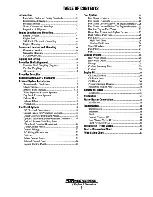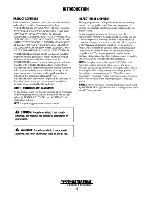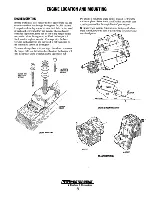
EMISSION-RELATED INSTALLATION INSTRUCTIONS
“Failing to follow these instructions when installing a certified engine in a piece of nonroad
equipment violates federal law (40 CFR 1068.105(b)), subject to fines or other penalties as described
in the Clean Air Act.”
If your product is equipped with OBD (on board diagnostics) go to
and follow
the free interface software download instructions specific to your engine to obtain and install the
appropriate diagnostic software. The following is a list of OBD compliant products:
20.0 SBEGA
22.5 SBEGA
To sample exhaust emissions on installed OBD compliant generators, gain access to the exhaust stream by
removing the test port plug on the exhaust elbow. Be sure to reinstall the plug securely when testing is
complete.
The Westerbeke generator that you purchased is certified for constant-speed operation only. The use
of any Westerbeke product in any manner inconsistent with its intended use could be a violation of
Federal Law.
“If you install the engine in a way that makes the engine's emission control information label hard to
read during normal engine maintenance, you must place a duplicate label on the equipment, as
described in 40 CFR 1068.105”. Contact the factory for an additional engine emission control
information label if needed to comply with this rule.
To comply with 40 CFR 1048.105 (a) “Fuel line permeation. For nonmetallic fuel lines, you must
specify and use products that meet the Category 1 specifications for permeation in SAE J2260
(incorporated by reference in §1048.810).”
To comply with 40 CFR 1048.105 (c) “Diurnal emissions. Evaporative hydrocarbon emissions may
not exceed 0.2 grams per gallon of fuel tank capacity when measured using the test procedures
specified in §1048.501. Diurnal emission controls must continue to function during engine operation.”
To comply with 40 CFR 1048.105 (d) “Running loss. Liquid fuel in the fuel tank may not reach
boiling during continuous engine operation in the final installation at an ambient temperature of 30
°C. Note that gasoline with a Reid vapor pressure of 62 kPa (9 psi) begins to boil at about 53 °C at
atmospheric pressure, and at about 60 °C for fuel tanks that hold pressure as described in
§1048.245(e)(1)(i)”.
To comply with 40 CFR 1048.245 (1) (i) “Use a tethered or self-closing gas cap on a fuel tank that
stays sealed up to a positive pressure of 24.5 kPa (3.5 psig); however, they may contain air inlets that
open when there is a vacuum pressure inside the tank. Nonmetal fuel tanks must also use one of the
qualifying designs for controlling permeation emissions specified in 40 CFR 1060.240.”
iv







































